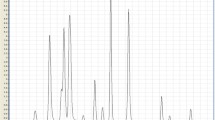Summary
Pholcodine (3-O-(2′-morpholinoethyl)-morphine) is used in many countries as an antitussive without analgesic or addictive properties. It is of forensic relevance that pholcodine interferes with opiate immunoassays. In this paper a gas chromatographic-mass spectrometric (GC-MS) procedure for the precise and sensitive detection of pholcodine and its metabolites in urine and hair, after acid hydrolysis, extraction and acetylation, is presented. Furthermore, detection of pholcodine using radio immunoassay (RIA), fluorescence polarisation immunoassay (FPIA) and enzyme immunoassay (EIA) for opiates is described. Using GC-MS, unmodified pholcodine could be detected in urine samples 4–7 weeks after ingestion of a single therapeutic dose of 50 mg of pholcodine, the desmorpholinohydroxy metabolite for 1–2 weeks and the other metabolites (nor-, nordesmorpholinohydroxy-, hydroxy-, oxo- and noroxo-pholcodine) only during the first few hours. Morphine could also be detected in urine samples for the first few days. It was however mainly formed artificially during acid hydrolysis and only in trace amounts by metabolism. All the immunoassays tested gave positive results in urine samples during the first week taking the cut-off values recommended by the manufacturer into consideration. If values between the cut-off and the detection limit were taken into consideration, RIA and FPIA gave positive results for 2–4 weeks and EIA up to 2 weeks. Pholcodine could also be detected by RIA and GC-MS in samples of head hair clipped 10 weeks after ingestion of 50 mg and in daily shaved samples of beard hair over a period of three weeks after ingestion of three doses of 60 mg. It can be concluded that the widely used immunoassays for opiates show positive results in urine and hair samples for a long time after ingestion of the non-opioid pholcodine and that these results can be confirmed by the GC-MS procedure described in this paper.
Zusammenfassung
Pholcodin (3-O-(2′-Moipholinoethyl)Morphin) wird in vielen Ländern als Antitussivum ohne analgetische oder suchterregende Potenz verwendet. Es ist aber insofern von forensischer Bedeutung, als es mit Immunoassays für Opiate interferiert. In der Arbeit wird ein gaschromatographisch-massenspektrometrisches (GC-MS) Verfahren beschrieben, das einen spezifischen und empfindlichen Nachweis von Pholcodin in Urin und Haaren nach saurer Hydrolyse, Extraktion und Acetylierung erlaubt. Desweiteren wird die Nachweisbarkeit von Pholcodin mittels Radioimmunoassay (RIA), Fluoreszenzpolarisationsimmunoassay (FPIA) und Enzymimmunoassay (EIA) beschrieben. Mittels GC-MS konnte unverändertes Pholcodin im Urin bis zu 4–7 Wochen nach der Einnahme einer einzigen therapeutischen Dosis von 50 mg nachgewiesen werden. Der Desmorpholinohydroxy-Metabolit konnte 1–2 Wochen, und die anderen Metaboliten (Nor-, Nordesmorpholinohydroxy-, Hydroxy-, Oxo- und Noroxo-Pholcodin) nur in den ersten Stunden erfaßt werden. Morphin konnte innerhalb der ersten paar Tage im Urin nachgewiesen werden. Es wurde jedoch hauptsächlich artefaktisch während der sauren Hydrolyse und nur in Spuren im Stoffwechsel gebildet. Alle getesteten Immunoassays lieferten unter Berücksichtigung der von den Herstellern empfohlenen Cut-Off-Werte in den Urinproben der ersten Woche positive Befunde. Unter Berücksichtigung von Meßwerten zwischen Cut-Off und Nachweisgrenze lieferten RIA und FPIA 2–4 Wochen und der EIA bis zu 2 Wochen “positive” Ergebnisse. Pholcodin wurde mittels RIA und GC-MS auch in Kopfhaarproben nachgewiesen, die 10 Wochen nach der Einnahme abgeschnitten worden waren. In Barthaaren, die nach der Einnahme von 3mal 60 mg Pholcodin bei der täglichen Rasur gesammelt worden waren, konnte Pholcodine drei Wochen lang nachgewiesen werden. Zusammenfassend kann festgestellt werden, daß die weitverbreiteten Immunoassays für Opiate in Urin und Haaren selbst lange Zeit nach der Einnahme des Nicht-Opioids Pholcodin in Urin und Haaren positive Ergebnisse liefern und daß alle diese Ergebnisse mit Hilfe des vorgestellten GCMS-Verfahrens bestätigt werden können.
Similar content being viewed by others
References
Butz RF, Jones EC, Welch RM, Findlay JWA (1983) Pharmacokinetics and O-dealkylation of morphine-3-alkyl ethers in the rat. Drug Metab Dispos 11:481–488
Cahen R (1961) The pharmacology of pholcodine. Bull Narc 13:19–36
Chabrier P, Giudicelli R, Thullier J (1950) Étude chimique, pharmacologique et clinique d'un nouveau sédative de la toux: la morpholinoéthylmorphine. Ann Pharm Fr 8:261–273
Eddy NB, Friebel H, Hahn KJ, Halbach H (1970) Codeine, and its alternatives for pain and cough relief. Bull WHO 40:160–164
Findlay JWA (1988) Review: pholcodine. J Clin Pharm Ther 13:5–17
Fritz CF (1990) Pholcodin: Metabolismus beim Menschen und toxikologische Analytik in Urin und Haaren. Dissertation, Homburg (Saar), FRG (in preparation)
Maurer HH (1988) Die „General-Unknown”-Anlayse als Grundlage der klinisch-toxikologischen Analytik. Habilitation thesis, Homburg (Saar), FRG
Maurer HH, Fritz CF (1990a) Zum forensisch-toxikologischen Nachweis von Pholcodin in Urin und Haaren. Beitr Gerichtl Med 48:37–39
Maurer HH, Fritz CF (1990b) Metabolism of pholcodine in man. Drug Res 40:564–566
Maurer H, Pfleger K (1984) Screening procedure for the detection of opioids, other potent analgesics and their metabolites in urine using a computerized gas chromatographic-mass spectrometric technique. Fresenius Z Anal Chem 317:42–52
Möller MR (1989) Personal communication
Möller MR, Sachs H, Biro G (1989) Detection of drugs in hair by RIA and GC-MS. Presentation reported at the 41th meeting of the American Academy of Forensic Sciences, Las Vegas (NV), February 15–19, 1989
Pfleger K, Maurer HH, Weber A (1990a) Mass spectral library of drugs, pesticides, poisons and their metabolites, 2nd rev. Hewlett Packard, Palo Alto (CA) (in press)
Pfleger K, Maurer HH, Weber A (1990b) Mass spectral and GC data of drugs, pesticides, poisons and their metabolites, 2nd edn. VCH-Verlagsgesellschaft, Weinheim New York Basel (in press)
Svenneby G, Wedege E, Karlsen RL (1983) Pholcodine interference in the immunoassay for opiates in urine. Forensic Sci Int 21:223–226
Author information
Authors and Affiliations
Rights and permissions
About this article
Cite this article
Maurer, H.H., Fritz, C.F. Toxicological detection of pholcodine and its metabolites in urine and hair using radio immunoassay, fluorescence polarisation immunoassay, enzyme immunoassay and gas chromatography-mass spectrometry. Int J Leg Med 104, 43–46 (1990). https://doi.org/10.1007/BF01816483
Received:
Revised:
Issue Date:
DOI: https://doi.org/10.1007/BF01816483




